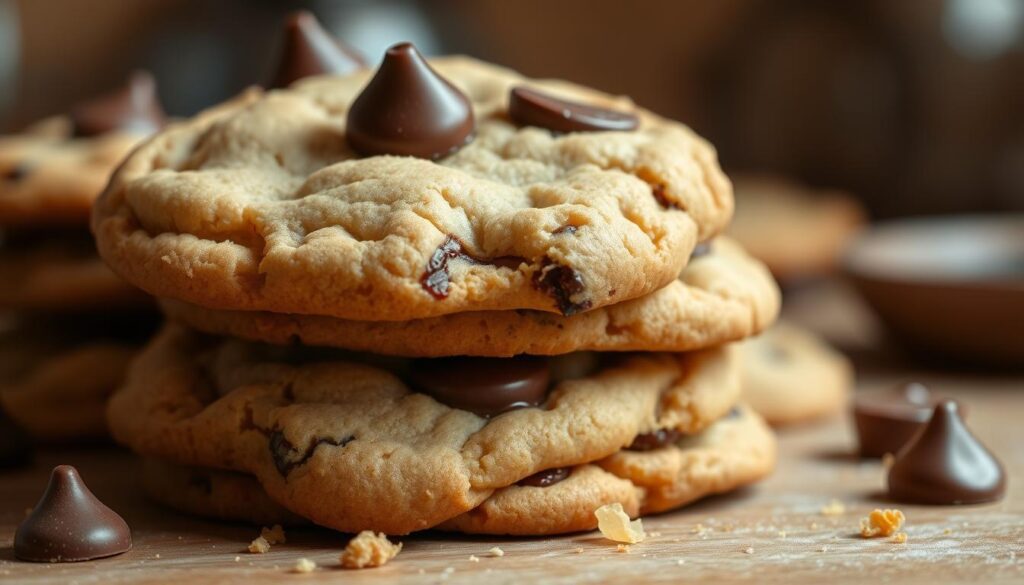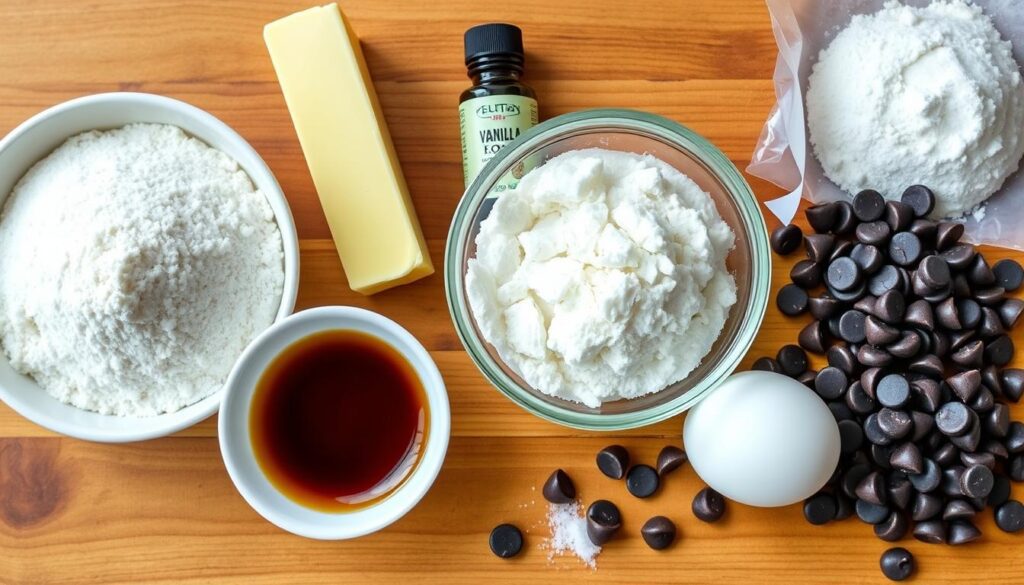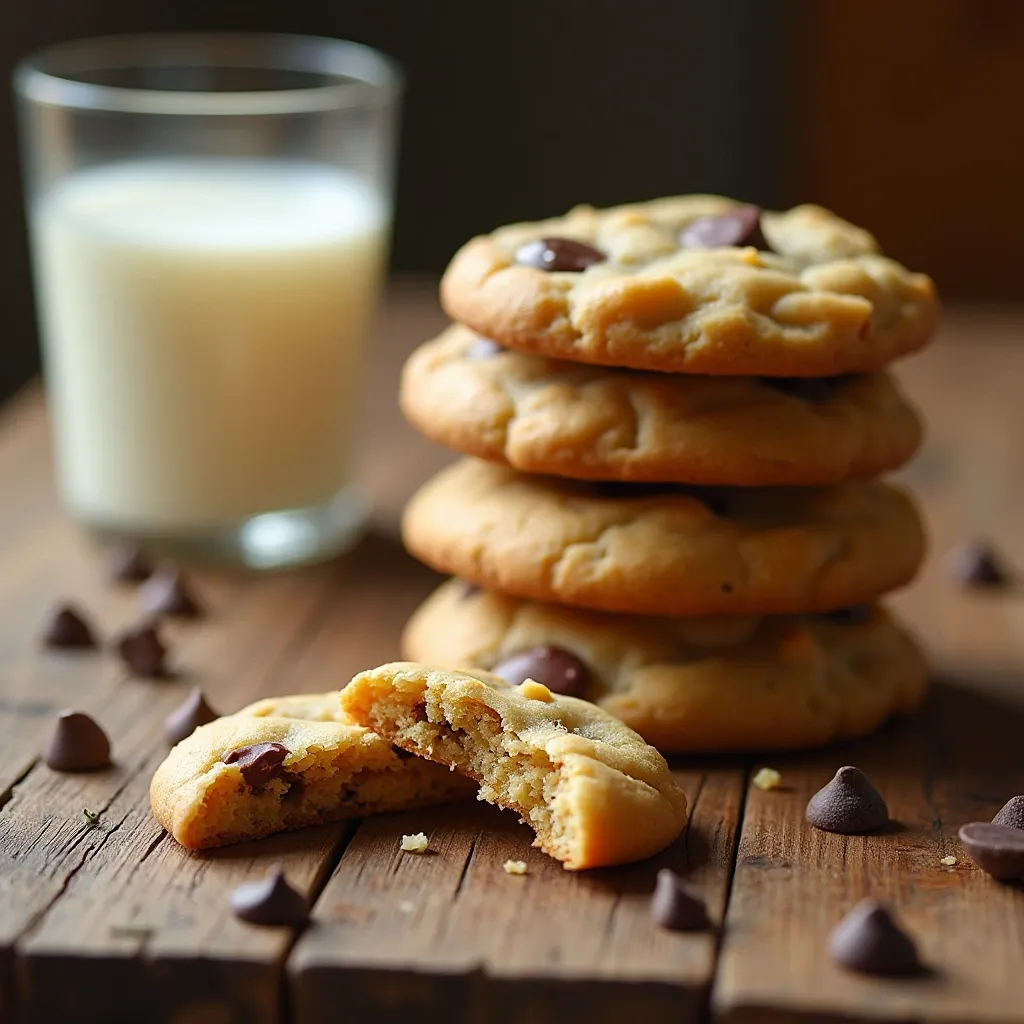Soft and chewy cookies are a treat like no other. They make baking a joy, unlike dry or cakey cookies. We’ll share top tips from the Nestlé Toll House Cookbook to help you get it right. You’ll learn how to balance moisture and fat for those beloved chewy cookies.

Get ready for more tips and tricks in the next sections. We’ll dive into the ingredients and methods for perfect cookies every time.
Key Takeaways
- Soft and chewy cookies offer a delightful texture that many prefer.
- Understanding moisture and fat balance is key to successful baking.
- Referring to reliable cookbooks like the Nestlé Toll House Cookbook can enhance your baking skills.
- Implementing specific cookie baking tips can improve the outcome of your recipes.
- Preparing for the ingredients and methods covered in the article is essential for making the best cookies.
The Importance of Texture in Cookies
Cookie texture is key to enjoying this favorite treat. The crunch of a crispy cookie or the chewiness of a soft one offers a unique taste with each bite. The debate between chewy and crispy cookies shows how personal taste can shape recipes and methods.
Baking science shows that the mix of ingredients in cookie dough determines texture. The right balance of fat, sugar, and flour is crucial. More moisture means a chewier cookie, while less leads to a crispy one.
How you bake also changes cookie texture. Things like oven temperature and baking time can make big differences. The perfect cookie combines different textures, making every bite exciting. Whether it’s the chewiness or the crunch, it’s all about the experience.

Key Ingredients for Soft and Chewy Cookies
Making soft and chewy cookies needs the right ingredients. Each one affects the taste, texture, and moisture. Knowing how they work together is key to your baking success.
The Role of Butter in Your Cookie Dough
Butter is crucial for flavor and texture in cookies. Use softened unsalted butter for the best results. It mixes well with sugars, making the dough creamy.
Creaming butter with sugar adds air. This makes the cookies light and structured. Choose high-quality butter for a better taste.
Understanding the Sugar Types
Sugar types change how cookies feel and taste. Brown sugar keeps cookies moist and chewy. White sugar makes them crisper.
Using both sugars is often the best choice. It balances the texture and taste. Many, like those using the Nestlé Toll House recipe, agree.
Hydration with Eggs and Their Impact on Texture
Eggs add moisture and help mix ingredients. The mix of egg yolk and white is important. Egg yolks make cookies richer, while whites make them lighter.
Choosing large eggs can make cookies more moist. Knowing how eggs affect texture helps make chewy cookies.

| Ingredient | Type | Impact on Texture |
|---|---|---|
| Butter | Unsalted | Creates creamy consistency; enhances flavor |
| Sugar | Brown Sugar | Increases moisture; promotes chewiness |
| Sugar | White Sugar | Provides crispness |
| Eggs | Whole Eggs | Adds moisture; binds ingredients |
| Egg Yolk | Richness | Adds fat; enhances texture |
| Egg White | Structure | Helps achieve lightness |
What Is the Secret to Making Cookies Soft and Chewy?
The secret to chewy cookies is all about balance. It’s about knowing how to mix and bake the right way. Both new and experienced bakers agree on the key steps to get that perfect chewiness.
One important trick is to bake cookies a bit less than usual. This keeps them moist and soft inside. Also, using more brown sugar than white sugar adds flavor and keeps the cookies moist longer.
Putting these tips together with the right ingredients is crucial. The mix of fats, sugars, and how you bake them all matters. Following these steps will help you make cookies that are truly soft and chewy.
| Technique | Description | Result |
|---|---|---|
| Underbaking | Baking cookies until they are just set but still soft in the center | Creates a chewy texture |
| Higher Brown Sugar Ratio | Using more brown sugar than white sugar | Enhances moisture retention |
| Ingredient Balance | Mixing fats, sugars, and hydration correctly | Achieves perfect cookie consistency |
Measuring Your Ingredients Accurately
Getting the perfect cookie often depends on one key thing: accurate measurements. Using kitchen scales for measuring ingredients helps you get consistent and high-quality cookies. This method helps avoid mistakes and makes baking more fun.
The Importance of Kitchen Scales
Getting a good kitchen scale can really change your baking. Scales give you exact measurements, unlike measuring cups. For example, a cup of flour can weigh differently. Using a scale means you always get the right amount of flour, which is key for the right cookie texture.
Avoiding Common Measurement Mistakes
Baking needs careful attention to detail. Many bakers make mistakes that can change how their cookies turn out. These mistakes include:
- Packing flour into a measuring cup
- Using liquid measuring cups for dry ingredients
- Overthinking conversions between cups and grams
Each mistake can make a big difference in your recipe. Knowing how to avoid these errors is crucial for making perfect cookies. By focusing on precise measurements, you set yourself up for success in baking.
Mixing Techniques That Matter
Mixing techniques greatly affect cookie texture. Knowing the right mixing methods can make a big difference. The goal is to mix ingredients well without overworking the dough.
Beating dough is key, but timing is crucial. Overmixing makes cookies tough because of too much gluten. Undermixing, on the other hand, can cause uneven texture and flavor.
| Mixing Technique | Effect on Texture | Recommendation |
|---|---|---|
| Overmixing | Tougher, denser cookies | Avoid mixing past the point of incorporation |
| Undermixing | Ineven texture with unincorporated ingredients | Ensure all ingredients are well mixed |
| Optimal Mixing | Soft, chewy cookies | Mix until just combined |
Effective texture control is key to making great cookies. The right mixing techniques can make cookies soft and chewy. Aim to mix the dough just enough to blend all ingredients for the best results.
Baking Temperature: Finding the Perfect Balance
Getting the right cookie texture depends a lot on the baking temperature. Knowing about cookie baking science helps make treats that you love. Different temperatures can change how cookies spread, feel, and taste.
The Science Behind Oven Temperature
The temperature of your oven affects your cookies a lot. Baking at lower temperatures, like 325°F, makes cookies soft and chewy. This is because they bake slowly and keep their moisture.
On the other hand, baking at higher temperatures makes cookies crisp and firm. This happens because they brown faster and lose moisture quicker. Knowing how oven settings change cookies is key for improving texture.
Cooling Times and Their Effects on Cookie Texture
Cooling cookies the right way is also crucial for texture. Cooling them on the baking sheet keeps them chewy. This is because they use the oven’s heat to stay soft.
But, cooling cookies on wire racks makes them firmer. This is because they cool down faster. Finding the right mix of baking temperature and cooling time makes cookies that everyone will enjoy.
Using the Right Baking Sheets and Parchment Paper
Choosing the right baking sheets for cookies is key to getting the perfect cookie. Different sheet colors affect how cookies bake and brown. Light-colored sheets make cookies softer, while dark sheets make them firmer and crunchier.
Parchment paper is a big help in baking cookies. It prevents cookies from sticking to the pan, making them easy to remove. It also helps cookies bake evenly by spreading heat evenly.
Insulated baking sheets are great for soft cookies. They keep moisture in, making cookies chewy. When you’re setting up your cookie baking equipment, try these tips for the best results.
Chilling the Dough for Optimal Results
Dough chilling is key to getting the perfect cookie texture. When cookie dough rests in the fridge, it undergoes several beneficial changes. These changes include enhanced flavors and a better texture.
Chilling the dough lets the flour fully absorb the liquid. This blending of ingredients results in a richer taste. Each bite becomes more flavorful.
Chilling cookie dough also helps control how much cookies spread while baking. Without chilling, cookies might spread too much, becoming flat and unappealing. The cooler dough holds its shape better in the oven, making your cookies look as good as they taste. It’s recommended to chill the dough for at least 30 minutes to get these benefits.
In short, adding dough chilling to your baking routine brings many advantages:
- Enhances flavor development
- Improves overall cookie texture
- Reduces excessive spreading while baking
- Allows for better control over cookie shapes
| Chilling Time | Flavor Development | Spreading Control |
|---|---|---|
| 30 minutes | Good | Moderate |
| 1 hour | Better | Better |
| 2 hours | Best | Excellent |
Tips for Perfectly Soft and Chewy Cookies Every Time
To make cookies that are soft and chewy, you need to know a few key things. Use these cookie baking tips to get great results every time. Here’s a quick guide to help you improve your cookie-making skills:
- Select high-quality ingredients, like fresh butter and sugars.
- Use a kitchen scale to measure dry ingredients accurately.
- Put eggs at room temperature for better mixing.
- Chill the dough for at least 30 minutes to improve cookie structure.
- Bake at the right temperature to avoid over-baking.
- Store cookies in an airtight container to keep them soft.
These tips will help you make a perfect cookie recipe. Remember, baking cookies well takes patience and precision.
By following these tips, you’ll see a big improvement in your cookies. Enjoy baking, try new things, and look forward to delicious results every time!
| Tip | Description |
|---|---|
| Ingredient Quality | Choose organic or locally sourced butter and sugars for the best flavor. |
| Measurement | Use precise measurements with a scale to avoid dough inconsistencies. |
| Chilling | Allowing dough to chill prevents spreading and enhances chewiness. |
| Baking | Monitor oven temperature closely to avoid over-baking for optimal softness. |
| Storage | Seal cookies in airtight containers after cooling to retain moisture. |
Conclusion
Baking soft and chewy cookies is all about a few key things. It starts with choosing the right ingredients and using the right techniques. Butter, sugars, and eggs are crucial for that perfect texture.
Getting the measurements right and mixing correctly are important steps. These steps help make your cookies go from good to great. They make your baking experience better and more fun.
Also, baking at the right temperature and chilling the dough are musts. These steps make a big difference in how your cookies turn out. By following these tips, you can make cookies that are always delicious.
With practice, you can make your kitchen a place where soft and chewy cookies are always ready. You now have all the secrets to baking amazing cookies. So, get baking and enjoy the journey!
FAQ
What is the secret to making cookies soft and chewy?
To make cookies soft and chewy, you need the right mix of moisture and fat. Use more brown sugar than white sugar. Also, don’t overbake and make sure to use enough eggs.
Why does the type of sugar matter in cookie recipes?
Sugar type changes cookie texture. Brown sugar keeps cookies moist because of its molasses. White sugar makes them crisper. Mixing both gives the best taste, like in the Nestlé chocolate chip cookie recipe.
Does chilling the dough really make a difference?
Yes, chilling the dough improves flavor and texture. It lets flour hydrate fully and ingredients blend better. This stops cookies from spreading too much, making them chewy.
How important are accurate measurements in baking cookies?
Accurate measurements are key for consistent results. Using a kitchen scale is better than measuring by volume. It helps avoid mistakes and ensures reliable outcomes.
What mixing techniques should I use for the best cookie texture?
Mix just until ingredients are combined to avoid overmixing. Overmixing can make cookies tough. This simple trick can greatly improve their texture.
Does the baking temperature affect cookies?
Yes, baking temperature is crucial for cookie texture. Lower temperatures make cookies softer and chewier. Higher temperatures make them crisper. Cooling times also affect the final texture.
What baking sheets work best for cookies?
Light-colored baking sheets are best for softer cookies. Dark sheets promote browning. Parchment paper prevents sticking and ensures even cooking.
Can I use any type of butter for baking cookies?
Use unsalted butter for baking cookies for better salt control. Softened butter creates a creamy dough, essential for soft and chewy cookies.

